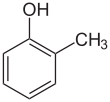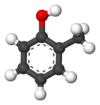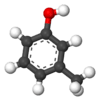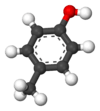Cresol
Cresols (also hydroxytoluene) are organic compounds which are methylphenols. They are a widely occurring natural and manufactured group of aromatic organic compounds, which are categorized as phenols (sometimes called phenolics). Depending on the temperature, cresols can be solid or liquid because they have melting points not far from room temperature. Like other types of phenols, they are slowly oxidized by long exposure to air, and the impurities often give samples of cresols a yellowish to brownish red tint. Cresols have an odor characteristic to that of other simple phenols, reminiscent to some of a "coal tar" smell. The name cresol reflects their structure, being phenols, and their traditional source, creosote.
| Isomers of Cresol[1][2][3][4] | ||||
|---|---|---|---|---|
| Skeletal formula |  |
 |
||
| Ball-and-stick model |  |
 |
 | |
| General | ||||
| Common name | o-cresol | m-cresol | p-cresol | |
| Preferred IUPAC name | 2-methylphenol | 3-methylphenol | 4-methylphenol | |
| Systematic name | 2-methylbenzenol | 3-methylbenzenol | 4-methylbenzenol | |
| Other names | ortho-Cresol 2-Hydroxytoluene |
meta-Cresol 3-Hydroxytoluene |
para-Cresol 4-Hydroxytoluene | |
| Molecular formula | C7H8O | |||
| SMILES | Oc1c(C)cccc1 | Oc1cc(C)ccc1 | Oc1ccc(C)cc1 | |
| Molar mass | 108.14 g/mol | |||
| Appearance at room temperature and pressure |
colorless crystals | thicker liquid | greasy-looking solid | |
| CAS number | [95-48-7] | [108-39-4] | [106-44-5] | |
| mixture of cresols (tricresol): [1319-77-3] | ||||
| Properties | ||||
| Density and phase | 1.05 g/cm3, solid | 1.03 g/cm3, liquid | 1.02 g/cm3, liquid | |
| Solubility in pure water at 20−25 °C |
2.5 g/100 ml | 2.4 g/100 ml | 1.9 g/100 ml | |
| soluble in strongly alkaline water | ||||
| Melting point | 29.8 °C (303.0 K) | 11.8 °C (285.0 K) | 35.5 °C (309.7 K) | |
| Boiling point | 191.0 °C (464.2 K) | 202.0 °C (475.2 K) | 201.9 °C (475.1 K) | |
| Acidity (pKa) | 10.287 | 10.09 | 10.26 | |
| Viscosity | solid at 25 °C | ? cP at 25 °C | solid at 25 °C | |
| Structure | ||||
| Dipole moment | 1.35 D | 1.61 D | 1.58 D | |
| Hazards | ||||
| SDS | ||||
| Main hazards | flammable, ingestion and inhalation toxicity hazard | |||
| Flash point | 81 °C c.c. | 86 °C | 86 °C c.c. | |
| R/S statement | R24/25-R34 ((S1/2)-)S36/37/S39-S45 | |||
| RTECS number | ||||
| Related compounds | ||||
| Related phenols | xylenols | |||
| Related compounds | bromo cresol | |||
| Except where noted otherwise, data are given for materials in their standard state (at 25 °C, 100 kPa) Infobox disclaimer and references | ||||
Structure and production
In its chemical structure, a molecule of cresol has a methyl group substituted onto the ring of phenol. There are three forms (isomers) of cresol: ortho-cresol (o-cresol), meta-cresol (m-cresol), and para-cresol (p-cresol). These forms occur separately or as a mixture, which can also be called cresol or more specifically, tricresol. About half of the world's supply of cresols are extracted from coal tar. The rest is produced by hydrolysis of chlorotoluenes or the related sulfonates. Another method entals methylation of phenol with methanol over a solid acid catalyst, often comprising magnesium oxide or alumina. Temperatures above 300 °C are typical. Anisole converts to cresols under these conditiions.[5][6]
Applications
Cresols are precursors or synthetic intermediates to other compounds and materials, including plastics, pesticides, pharmaceuticals, and dyes.[6]
Most recently, cresols have been used to create a breakthrough in manufacturing carbon nanotubes at scale that are separated and not twisted, without additional chemicals that change the surface properties of the nanotubes.[7][8]
Commercial examples
Derivatives of p-cresol include:
- Bupranolol, a non-selective beta blocker
- Butylated hydroxytoluene, a common antioxidant
- Indo-1, a popular calcium indicator
Derivatives of o-cresol include:
- MCPA, (4-chloro-2-methylphenoxy)acetic acid
- MCPB, 4-(4-chloro-2-methylphenoxy)butanoic acid
- Mecoprop, (RS)-2-(4-chloro-2-methylphenoxy)propanoic acid
- the amine atomoxetine, (3R)-N-methyl-3-(2-methylphenoxy)-3-phenylpropan-1-amine
- the diol mephenesin, 3-(2-methylphenoxy)propane-1,2-diol
Derivatives of m-cresol include:
- Amylmetacresol, an antiseptic
- Bevantolol, (RS)-[2-(3,4-dimethoxyphenyl)ethyl][2-hydroxy-3-(3-methylphenoxy)propyl]amine
- Bromocresol green
- Chloro-m-cresol which is used as a household disinfectant
- Tolimidone, 5-(3-methylphenoxy)pyrimidin-2(1H)-one
Health effects
When cresols are inhaled, ingested, or applied to the skin, they can be very harmful. Effects observed in people include irritation and burning of skin, eyes, mouth, and throat; abdominal pain and vomiting; heart damage; anemia; liver and kidney damage; facial paralysis; coma; and death.
Breathing high levels of cresols for a short time results in irritation of the nose and throat. Aside from these effects, very little is known about the effects of breathing cresols, for example, at lower levels over longer times.
Ingesting high levels results in kidney problems, mouth and throat burns, abdominal pain, vomiting, and effects on the blood and nervous system.
Skin contact with high levels of cresols can burn the skin and damage the kidneys, liver, blood, brain, and lungs.
Short-term and long-term studies with animals have shown similar effects from exposure to cresols. No human or animal studies have shown harmful effects from cresols on reproduction.
It is not known what the effects are from long-term ingestion or skin contact with low levels of cresols.
The Occupational Safety and Health Administration has set a permissible exposure limit at 5 ppm (22 mg/m3) over an eight-hour time-weighted average, while the National Institute for Occupational Safety and Health recommends a limit of 2.3 ppm (10 mg/m3).[9]
See also
References
- o-CRESOL (ICSC)
- m-CRESOL (ICSC)
- p-CRESOL (ICSC)
- Pubchem. "o-cresol". pubchem.ncbi.nlm.nih.gov. Retrieved 2018-01-16.
- W. W. Hartman (1923). "p-Cresol". Organic Syntheses. 3: 37. doi:10.15227/orgsyn.003.0037.
- Helmut Fiegein "Cresols and Xylenols" in Ullmann's Encyclopedia of Industrial Chemistry" 2007; Wiley-VCH, Weinheim. doi:10.1002/14356007.a08_025
- "Making carbon nanotubes as usable as common plastics: Researchers discover that cresols disperse carbon nanotubes at unprecedentedly high concentrations". ScienceDaily, Northwestern University. 15 May 2018. Archived from the original on 2018-05-16.
- Chiou, Kevin; Byun, Segi; Kim, Jaemyung; Huang, Jiaxing (29 May 2018). "Additive-free carbon nanotube dispersions, pastes, gels, and doughs in cresols". Proceedings of the National Academy of Sciences. 115 (22): 5703–5708. Bibcode:2018PNAS..115.5703C. doi:10.1073/pnas.1800298115. PMC 5984515. PMID 29760075.

- Documentation for Immediately Dangerous To Life or Health Concentrations (IDLHs) - Cresol (o, m, p isomers)